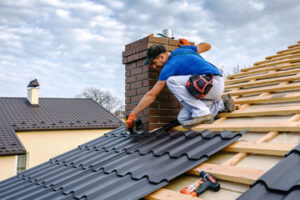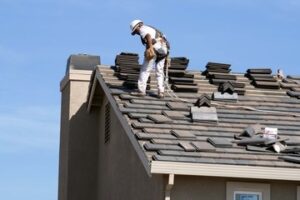Your roof protects your home from obvious dangers like weather events, falling tree branches and excess moisture, but it also protects the rafters, walls and foundation of your building. A well-maintained roof is a major investment that protects your entire building structure and the occupants inside.

Timely repairs can prevent small issues from becoming a bigger problem that requires a full roof replacement. Visit https://www.portcharlotteroofers.com/ to get you started.
Gutters and downspouts play a critical role in the roof. They funnel rain and stormwater away from the foundation of the house, and if they’re clogged or damaged, it can lead to water damage on the exterior walls of the home as well as water leaks into the basement or crawl space.
While it’s not the most fun part of homeownership, a clean gutter is essential to a healthy roof. If a home’s gutters and downpipes are full of leaves, debris or ice dams, they’ll be unable to function properly during a rainfall. This will cause the water to overflow and spill onto the roof or facades, potentially damaging them. It also allows the water to seep under shingles, behind siding and into the foundation, which can lead to costly repairs down the road.
Clogged gutters are also an inviting environment for pests, such as ants, wasps and rodents, and can create a damp, rotting mess that attracts mosquitoes. Finally, if a clogged gutter becomes heavy with ice, it can pull away from the roof, causing more damage to the structure of the house.
A clogged gutter can be easily prevented by regular cleaning and maintenance. It’s recommended that homeowners clean their gutters twice a year, once in the spring and again in the fall. Regular cleanings ensure that any leaves and twigs are removed and that the downspouts are clear. It’s also recommended that homeowners trim any trees that are hanging over their gutters, to prevent the branches from dropping into the gutters.
When cleaning your gutters, start at one end of the house and work your way to the other. Use a hose to wash and vacuum the gutters, ensuring that all the leaves, twigs and sludge are suctioned away. Next, direct the nozzle of the hose into each downspout to ensure that they’re clear. When you’re done, make sure to dispose of the collected debris appropriately.
Check the Shingles
Shingle roofs contain granules that help protect the asphalt layer from UV radiation and provide fire resistance. Over time, shingles can lose these granules due to environmental wear-and-tear or structural damage. If you notice granules collecting in gutters or dislodged in your yard, it’s a good idea to contact a roofer to check for any potential issues with your shingles.
Missing shingles are perhaps the most obvious sign of roof damage and should be addressed immediately. This leaves the underlying roof exposed to weather and other hazards. You can often see shingle holes from the ground, but it’s best to get up on a ladder for the most thorough inspection.
Curled and buckled shingles are also common signs of roof problems. These shingles may not be damaged or worn out, but they’re more likely to hold water and cause further problems in the future. Curled shingles tend to absorb more moisture, and buckled shingles can retain moisture even after rain or snow.
During your routine roof inspections, look for moss or algae on the shingles. These plants love damp environments, and their roots can eat through the shingles to the wood decking below. Moisture in the shingles can lead to material decay, so you should remove any moss or algae as soon as it appears on your roof.
If you have skylights or a chimney, make sure that these are properly sealed to prevent water leaks. It’s also important to check the integrity of the caulk around any vent pipes or ductwork that extend through your roof. Finally, you should regularly trim overhanging branches to avoid potential damage during a storm.
A healthy shingle roof is well ventilated to allow hot air to escape and prevent moisture from accumulating inside the attic or walls of your home. Look for blocked vents or obstructed insulation during your shingle roof maintenance and address them as needed.
Check the Flashings
Flashing is a crucial roof component that redirects water to gutters and prevents leakage in vulnerable areas. It also protects the roof from moisture accumulation, which can lead to rotting or mold. A regular inspection of your flashing can help you keep on top of any problems, and it’s a good idea to replace the caulking that seals the flashing every few years. Look for dents, corrosion, and gaps in the flashing to determine its condition.
Flashings can be damaged by inclement weather or physical damage, and a cracked or broken flashing creates openings for moisture penetration. If left unchecked, this type of damage can lead to sagging roofing and rotted insulation. Water that seeps through roof flashing can also cause mold and mildew in the attic or walls, which can be a health hazard.
Water stains on ceilings or walls are a telltale sign that the flashing needs replacement or repair. You should inspect the flashing every time you do a visual check of your roof. Start by checking for rust or corrosion, as well as any dents in the metal. Inspect the area around the chimney and vent pipes for damage to the flashing, and be sure to check for any gaps or loose pieces.
Once you’ve inspected the flashing for signs of damage, you can make repairs if necessary. For instance, you can use a roof sealant to fix any cracks or gaps in the flashing. It’s best to use a sealant that matches the color of your roof, so it blends in and doesn’t stand out.
You can also use roof flashing tape to cover small holes in the flashing. However, this is only a temporary solution, and you should have a professional come out to address the problem permanently for long-term protection. For best results, inspect your flashings regularly and make any necessary repairs before winter arrives. This will help ensure that your roof can withstand the heavy snow, freezing temperatures, and ice dams of winter. It will also help you avoid costly leaks and other structural damage down the road.
Check the Soffit
The fascia and soffit protect your roof from water damage and pest infestations, provide ventilation for your attic and give your home a finished look. If either of these structures are damaged or not functioning properly, it can lead to serious and costly problems for the rest of your roof and home. If you suspect there is a problem with your soffit, it is important to have it repaired as soon as possible to avoid expensive roof repairs in the future.
The first sign that your soffit is damaged is often discoloration or water marks. It may also be sagging. If you have any of these issues, it is critical to have your soffit and fascia professionally repaired before the problem gets out of control.
Another sign that your soffit is not working as it should is mold growth or rotted wood. You can check for rotting by tapping the soffit gently with a screwdriver. If pieces begin to fall off, the soffit is likely rotting and needs to be replaced.
It is also important to regularly inspect your soffit for signs of insect infestations, such as ants, wasps and bees. These pests love to build nests in the space under your eaves. They can cause a number of problems for your home, including structural damage to the soffit and fascia, attic leaks, mold and rot.
As you can see, proper roof maintenance is crucial for preserving your home’s value and curb appeal. Inspecting and cleaning your soffit, roof, gutters and siding on a regular basis is an effective way to prevent damage and keep your home in good condition. By catching problems before they become serious, you can avoid costly repairs and extend the lifespan of your roof and other exterior elements of your home. Then you can relax and enjoy your beautiful home!

